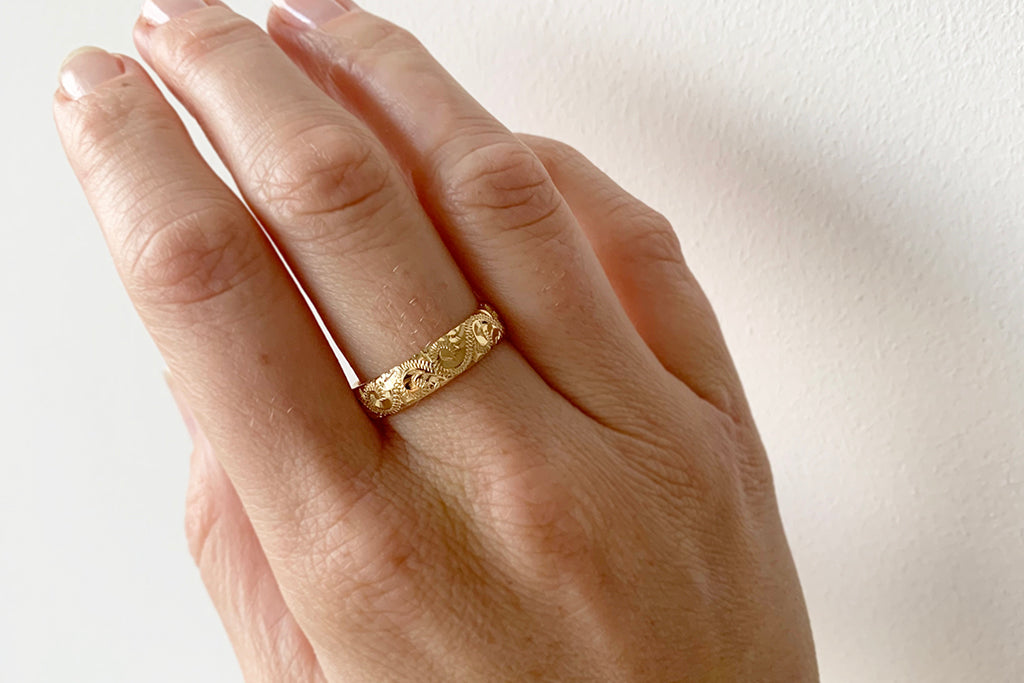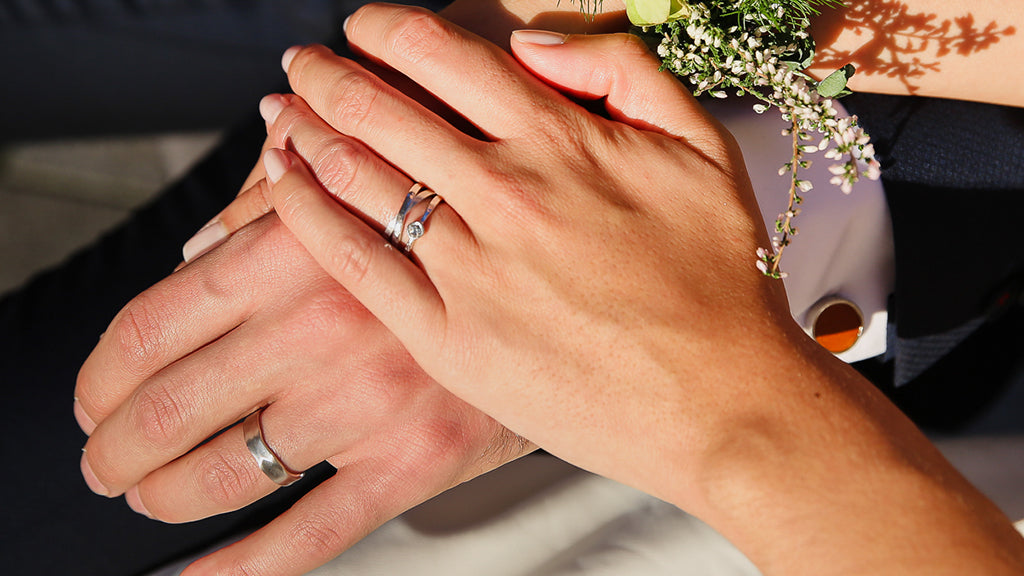Your Cart is Empty
 Our Scrolls wedding band in yellow gold and a semi-bespoke 5mm width
Our Scrolls wedding band in yellow gold and a semi-bespoke 5mm width
Generally speaking, gold comes in three basic colours: yellow, white, and rose.
The hue of gold jewellery can evolve over time due to general wear and chemical reactions with the environmental elements it comes into contact with you. In our experience, the gold most prone to changing in appearance is white gold.
 Bespoke white gold wedding bands and a bespoke engagement ring for Daniel and Vivianne
Bespoke white gold wedding bands and a bespoke engagement ring for Daniel and Vivianne
White gold isn't completely white; in fact, it's more a yellowish white.
This is because 18ct gold alloys consists of 75% pure yellow gold and 25% other metals. In the case of white gold, the 25% is a mix of white metals like silver, nickel, manganese and palladium, employed to make the finished product as bright and colourless as possible. However, even with these elements present, a totally white hue is rarely achieved - which is why white gold is often plated in a final white coating.
There are two types of 18ct white gold generally used in jewellery making. The first, and our preferred option, is “high palladium white gold”, which is naturally whiter. Palladium is an exceptionally white metal, so when the 25% of other metals has a high palladium content, a seriously white tone can be achieved.
"This palladium mix will appear white for much longer, even after the plating begins to wear thin, as the gold underneath is naturally whiter."
The other is 'standard white gold', coated in rhodium. In this case, the 25% of other metals is a mix of cheaper elements that aren't as white as palladium. When the rhodium plating wears away from gold like this, the layer revealed beneath is yellowish-white in hue.
In both cases, every few years, you may have your white gold jewellery re-dipped in rhodium to maintain its silvery appearance and make it shine like new again. Most jewellers will offer this service for free or an affordable price.
 Our Diamond Starwedding ring
Our Diamond Starwedding ring
Yellow and rose gold can also change colour due to oxidation or chemical reactions.
Oxidation is a process caused simply by daily exposure to oxygen, which can eventually affect the colour of various precious metals over time. For example, oxidisation is what causes silver to turn black, or copper to turn blue. (Did you know that the Statue of Liberty started her life a reddish-brown hue?) We always advise storing your unworn silver jewellery in zip-lock bags, away from humidity and air. This will significantly decrease the chances of fast-paced oxidisation.
If you work in environments that expose you to heat and fire (think kitchens or forges), you could be exposing your ring to too much heat, which could also be a catalyst for colour change. This process is called thermochromism.
Sometimes, the chemicals in the perfume, soap and cleaning agents that you use can cause discolouration. Even the naturally occurring produced by your skin can dull or discolour gold jewellery. If you notice stains on your wedding band that simply won’t shift, you may need to have your jewellery cleaned and re-polished by a jeweller. This type of tough stain can occur when the metal alloy in the gold jewellery (the 25%) - like the copper in rose gold - has reacted differently than the gold itself (the 75%).
 Our Diamond Flowerwedding ring
Our Diamond Flowerwedding ringPlatinum is a super stable metal and so a platinum wedding ring will retain its colour consistently from the day it's slipped onto your finger for the first time. This resilience is the reason that platinum is the traditional choice for bridal jewellery; it's perfect from everyday wear.
On the other hand, platinum does appear slightly less sparkly and shiny than brand new white gold, so it might not catch your eye in the shop in the same way.
 Our Artisan Filigree wedding band collection
Our Artisan Filigree wedding band collection
Good luck and don't forget that we're here to help. If you have any questions about our maintenance services, reach out today.
